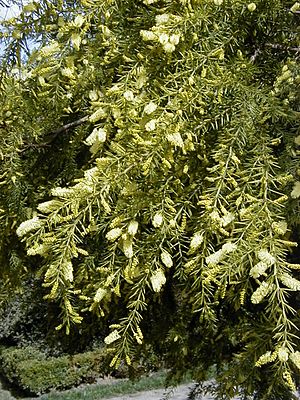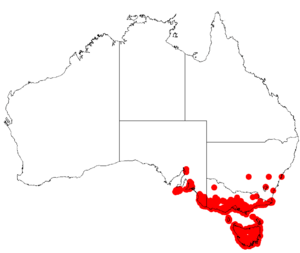Prickly moses facts for kids
Quick facts for kids Prickly moses |
|
|---|---|
 |
|
| Scientific classification | |
| Genus: |
Acacia
|
| Species: |
verticillata
|
 |
|
| Occurrence data from AVH | |
| Synonyms | |
|
|
Prickly Moses, also known as Acacia verticillata, is a cool plant that grows as a shrub or a small tree. It's found naturally in southeastern Australia. It's called "prickly" because of its sharp leaves! This plant is a perennial, which means it lives for more than two years.
Contents
What Prickly Moses Looks Like
This shrub or tree can grow up to about 10 m (33 ft) (that's like a three-story building!). It spreads out, making it quite bushy. Its branches have tiny, bristly spikes called stipules, which are only about 0.5 to 2 mm (0.020 to 0.079 in) long.
Leaves and Flowers
Like most Acacia plants, Prickly Moses doesn't have regular leaves. Instead, it has special flattened stems called phyllodes. These phyllodes are evergreen, meaning they stay green all year. They grow in groups, packed closely together, and look like they're arranged in a circle (called a whorl). They can be thin and straight or shaped like a spear, usually 5 to 25 mm (0.20 to 0.98 in) long and 1 to 7 mm (0.039 to 0.276 in) wide.
The phyllodes feel smooth (they are glabrous), are quite sharp, and have one main vein you can see.
Prickly Moses blooms between July and December. It produces simple flower clusters (called inflorescences) on smooth stalks. These stalks are about 2 to 5 mm (0.079 to 0.197 in) long. The flower-spikes are oval or round, up to 4.5 cm (1.8 in) long, and packed with bright yellow flowers.
Seed Pods
After the flowers, the plant forms flat, long seed pods. These pods are not very pinched between each seed. They are 2 to 8 cm (0.79 to 3.15 in) long and 3 to 5 mm (0.12 to 0.20 in) wide, with thin sides. The seeds inside are oval-shaped, about 3 to 4 mm (0.12 to 0.16 in) long. Each seed has a thread-like attachment (a funicle) that folds and gets thicker, forming a cup-shaped part called an aril.
How Prickly Moses Was Named
The Prickly Moses was first officially described in 1806 by a scientist named Charles Louis L'Héritier de Brutelle. This was part of a bigger project by Carl Ludwig Willdenow called Species Plantarum. Later, in 2003, another scientist, Leslie Pedley, reclassified it. But then, in 2006, it was moved back to the Acacia group.
Different Types of Prickly Moses
Scientists have found four different types, or subspecies, of Prickly Moses:
- Acacia verticillata subsp. verticillata
- Acacia verticillata subsp. ruscifolia
- Acacia verticillata subsp. cephalantha
- Acacia verticillata subsp. ovoidea
Where Prickly Moses Grows
A. verticillata is endemic to Australia, meaning it's only found there naturally. You can find it in New South Wales, Victoria, South Australia, and Tasmania.
This plant often grows as a common shrub under taller trees in both wet and dry sclerophyll forests. It also likes scrubland and heath areas. If you see it near the coast, its leaves might be wider than those growing inland, which usually have a needle-like shape.
The plant's range stretches from the Gulf St Vincent in South Australia, through southeastern Victoria, and into far southeastern New South Wales. It also grows in Tasmania, including the islands in Bass Strait. It likes salty areas, riverbanks, and mountain foothills.
Uses of Prickly Moses
Prickly Moses is sold to people who want to grow it in their gardens. It can grow well in full sun or partial shade. It's quite adaptable and can grow in different places like plains, hills, and even near the coast (but not right on the beach). It likes clay or loam soils that can be alkaline (basic), neutral, or acidic. It can also handle dry spells (drought), too much water (water logging), and some frost.
It's a great plant for providing habitat for birds. However, it catches fire easily, so it's not a good idea to plant it close to houses in areas where bushfires are common.
Long ago, Indigenous Australian people used the strong fibers from this plant to make fishing lines.
Prickly Moses in Popular Culture
On September 1, 2016, the Reserve Bank of Australia released a new five-dollar note. This new banknote actually features a picture of Acacia verticillata (specifically the ovoidea subspecies)!

